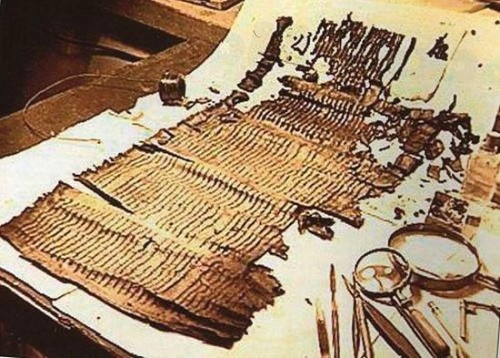On an otherwise nondescript day in the spring of 1947, a young Bedouin boy searched for a goat that had strayed from his flock just northwest of the Dead Sea. While he was looking, Muhammed the Wolf, as the boy was known, noticed a series of small caves in the limestone cliff above him. Thinking his goat may have gone into one of those caves, and not wanting to make the dangerous climb himself, Muhammed picked up a rock and threw it in.
What he heard was totally unexpected. He didn’t hear the bleat of a startled goat or the dull thud of a rock landing in the soft sand in the base of the cave. Rather, he heard the crisp, oddly tinny sound of shattering ceramics. His curiosity piqued, Muhammed made the difficult climb to the cave entrance. Once his eyes adjusted to the dim light inside, he was startled to see seven tall, cylindrical jars that contained documents no human had beheld for nearly 2,000 years: the Dead Sea Scrolls.
They did not know what they had come upon, but they sold the scrolls to a nearby dealer. This was the opening chapter to an astonishing archeological find; eventually some 800 different manuscripts would be found in eleven caves near the valley called Wadi Qumran. In all, some 60,000 fragments, portions, or complete scrolls of these 800 manuscripts were retrieved, covering many subjects.
Many of the documents contained biblical texts. Either fragments or complete copies were found of every book in the Old Testament except Esther. They had been placed in these caves around the middle of the first century AD, and the amazing fact is that they had lain there undisturbed for 1900 years! But why are these Dead Sea Scrolls so important for us? The reason is that before this discovery the earliest manuscripts of biblical texts dated from the ninth century after Christ. They were copies of earlier copies which were long lost.
But now, for example, we have a scroll of the complete book of Isaiah dating from the second century before Christ. It is a thousand years older than any previous Hebrew Scripture document that we had before 1947.
So as these scrolls were painstakingly unrolled and translated, biblical scholars and Christians everywhere wondered what the results would be. Would the new finds provide contradictory texts, quite different from the text of our Bibles? Would the Bible have to be altered or expanded?
Even though not all of the scrolls are unrolled and translated more than half a century later, the answers are coming clear. The texts are amazingly similar to the documents we already have. The variations are less than two percent, and not a single teaching or doctrine of the Bible we have is altered. Rather than posing a threat to the Christian faith, the Dead Sea Scrolls have, in fact, provided convincing support for the genuineness of God’s revelation as given to us in the Bible.
Nevertheless, Bible scholars are having intense debates about some of the texts. For example, some new Bible translations have added approximately 70 words to the end of 1 Samuel 10. The passage tells us that a certain king Nahash gouged out the eyes of the Israelites. While the text itself is of little consequence, it raises some very basic questions. Are new parts of the Bible still coming to light? Don’t we have God’s complete revelation? How is this possible?
Such questions need a forthright answer, and that answer is to trust in God’s provision. This trust embraces our faith in His plan for the universe, and in His sending of His son to our needy world. Therefore, it also certainly embraces our trust in His revelation. If we trust Him with our destiny, we can trust His provision of exactly what we need to know and receive from Him.
The Dead Sea Scrolls have provided enormous light for Bible translators. The Scripture text we have today is clearly reliable and substantiated from these ancient scrolls. The challenge we face in responding to this marvelous find is to place our faith in God’s Word and in His provision of light on our path for time and eternity.
As parchment and papyrus artifacts, the Dead Sea Scrolls are about 2,000 years old, but the stories recorded in them are often much older (we know this through collaborative studies—by archaeologists, historians, linguists, theologians, and others—of artifacts and records other than the Dead Sea Scrolls that have corroborated the dates in question). In fact, some of the stories relayed in the Dead Sea Scrolls are about 3,000 years old, dating to the time of King David. During that period, Hebrew was not yet a written language. So far as we know, Hebrew was first written down in about 600 B.C. Its really shocking that many of the stories recorded in the Dead Sea Scrolls therefore existed for centuries as oral history!
If an archaeologist have to dismiss the veracity of Native American oral traditions simply because they are not written down, then simple logic forces to dismiss some of the accounts written in the Dead Sea Scrolls too, which also began as oral tradition. To do anything else would be to maintain a racist double standard.
A few years ago, linguists and a geographer in Australia documented instances in which humans have maintained accurate oral histories over 400 generations and up to 10,000 years. And according to historian Roger Echo-Hawk, Pawnee oral traditions document events that occurred during the last glaciation (at least 11,000 years ago), including humans crossing the Bering Sea into North America.
All of this confirms something which has been long suspected: Most humans, until very recently, desired and maintained cultural stability, not change. Change was a threat and was embraced only when absolutely necessary. And that is why Native American oral histories—and all oral histories, for that matter—were a reliable way of recording and learning from the past for thousands of years before writing was invented.

It all started with a stray goat.




